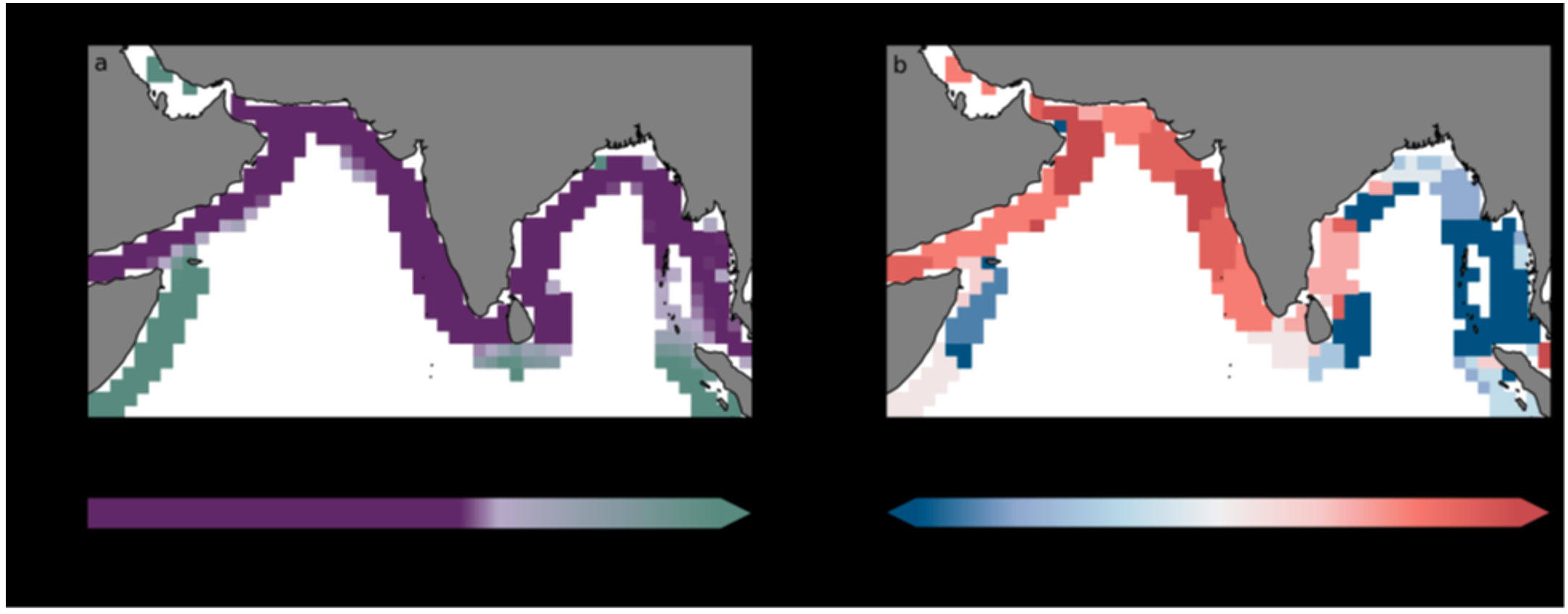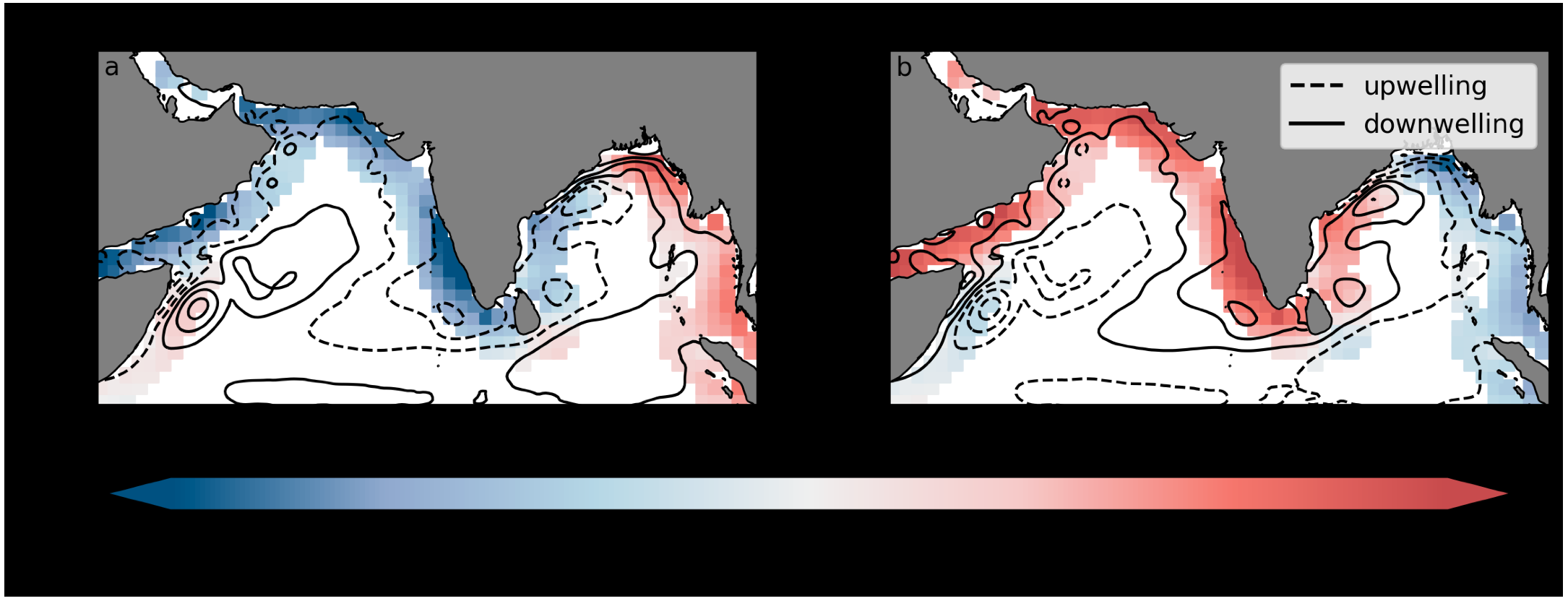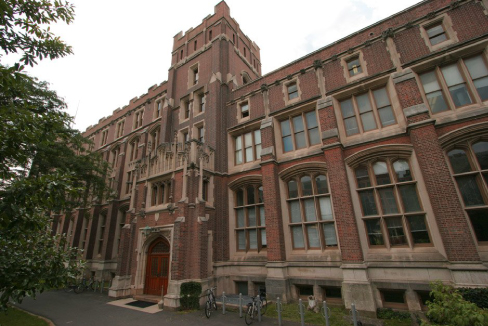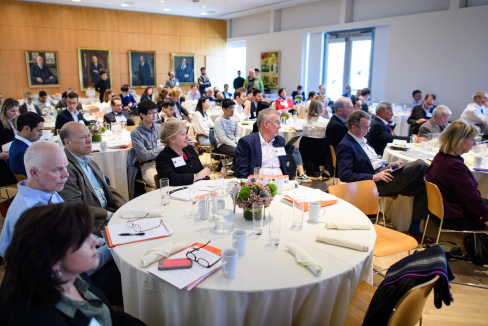Principal Investigators
At a Glance
Global warming and anthropogenic activities are contributing to a loss of oxygen in the world’s oceans (Bopp et al., 2017), creating what are called “coastal dead zones.” These are areas of extremely low oxygen that threaten coastal ecosystems and populations. The Resplandy group is evaluating the risk and studying the physical processes responsible for these dead zones in the tropical Indian Ocean — a particularly densely populated area.
Research Highlight
The tropical Indian Ocean is one of the few regions on Earth to host both natural oxygen minimum zones (OMZs) and humaninduced coastal dead zones, where oxygen concentrations reach hypoxic levels (< 63_mol=kg O2 ). Most organisms cannot survive under such low oxygen conditions (Levin et al., 2009), and dead zones often result in mass mortality or migration of marine life to more oxygenated waters. Reported cases of intense coastal dead zones have increased dramatically over the last few decades in the Indian Ocean (Breitburg et al., 2018). In 2001, a particularly intense event occurred along the western coast of India, which nearly collapsed shrimp fisheries (Wajih et al., 2009) — a vital component of India’s economy. Additionally, expansion of OMZs under climate change can bring oxygen-poor waters nearer the surface (Resplandy 2018; Busecke et al., 2019). This can alter the exchanges between oxygen-starved OMZ waters and coastal shelf waters prone to dead zones.
In this project, the Resplandy group quantifies the risk associated with seasonal and year-to-year variations in physical and biological processes that enhance hypoxic conditions, or push regions on the cusp into hypoxia. This is paramount to predict and anticipate impacts on biogeochemical cycles, the ecosystems these cycles support, and the commercial fishing industry that relies on healthy and robust populations to sustain local economies. To evaluate the risk of hypoxia, the researchers generated an unprecedented dataset that combines satellite data, autonomous floats, and ship-based oxygen measurements.

a) Minimum seasonal oxygen concentration at 50-200 m depth.
b) Month from the annual cycle corresponding to the minimum in a).
The dataset built by the Resplandy group reveals that the entire coastline in the northern Indian Ocean is hypoxic during at least one month of the year (Figure 9.1 a). Coastal hypoxia, and hence the risk of coastal dead zones, is most intense during summer/fall in the Arabian Sea and during winter/spring in the Bay of Bengal (Figure 9.1 b). The researchers further show that ocean circulation that promotes the exchanges between the Indian Ocean OMZs offshore and coastal shelf waters regulate oxygen levels. Specifically, upwelling brings nutrient rich and oxygen deficient waters from the OMZs onto the shelf – promoting hypoxia. The signature of upwelling can be identified by negative sea level anomalies in satellite images. The researchers find that extremely low oxygen levels in coastal waters (blue in Figure 9.2) occur when there is upwelling of oxygen poor waters from the OMZ offshore onto the shelf (dashed contours), highlighting the role of these physical exchanges in controlling or increasing the risk of coastal dead zones.

Oxygen anomaly (colors) and sea level anomaly (contours) in a) summer/ fall and b) winter/spring. Negative (positive) values indicate oxygen levels lower (higher) than the annual mean. Low oxygen levels (negative values in blue) occur when offshore waters are upwelled onto the coastal shelf (upwelling indicated by negative sea level anomaly in dashed contours).
This work demonstrates that hypoxia is prevalent in the Arabian Sea in summer/fall and in the Bay of Bengal in winter/ spring because of the upwelling of oxygen poor OMZ waters. The Resplandy group is currently investigating how modes of climate variability acting on year-to-year timescales enhance or suppress seasonal hypoxia and coastal dead zones in the northern Indian Ocean. Observations indicate that during some years this variability can offset seasonal upwelling in the Arabian Sea during summer/fall, decreasing the risk for coastal dead zones. However, during other years upwelling is induced year round in the Bay of Bengal and during winter/spring in the Arabian Sea, favoring low oxygen conditions and increasing the risk of coastal dead zones.
References
Bopp, L., L. Resplandy, A. Untersee, P. Le Mezo, and M. Kageyama, 2017. Ocean (de) oxygenation from the last glacial maximum to the twenty-first century: insights from earth system models. Philosophical Transactions of the Royal Society A, 375, 20160323. (https://doi.org/10.1098/rsta.2016.0323).
Breitburg, D., L.A. Levin, A. Oschlies, M. Grégoire, F.P. Chavez, D.J. Conley, V. Garçon, D. Gilbert, D. Gutiérrez, K. Isensee, et al., 2018. Declining oxygen in the global ocean and coastal waters. Science, 359(6371):eaam7240. (doi: 10.1126/science. aam7240).
Busecke, J.J.M., L. Resplandy, and J.P. Dunne, 2019. The equatorial undercurrent and the oxygen minimum zone in the Pacific. Geophysical Research Letters, 46(12):6716–6725. (https://doi.org/10.1029/2019GL082692).
Levin, L.A., W. Ekau, A.J. Gooday, F. Jorissen, J.J. Middelburg, S.W.A. Naqvi, C. Neira, N.N. Rabalais, and J. Zhang, 2009. Effects of natural and human-induced hypoxia on coastal benthos. Biogeosciences 6(10): 2063–2098. (https://doi.org/10.5194/bg-6-2063-2009).
Resplandy, L., 2018. Will ocean zones with low oxygen levels expand or shrink? Nature, 557:314–315. (DOI: 10.1038/d41586- 018-05034-y).
Wajih, S., A. Naqvi, H. Naik, A. Jayakumar, A.K. Pratihary, G. Narvenkar, S. Kurian, R. Agnihotri, M.S. Shailaja, and P.V. Narvekar, 2009. Seasonal anoxia over the western Indian continental shelf. Indian Ocean Biogeochemical Processes and Ecological Variability, 185:333–345.






